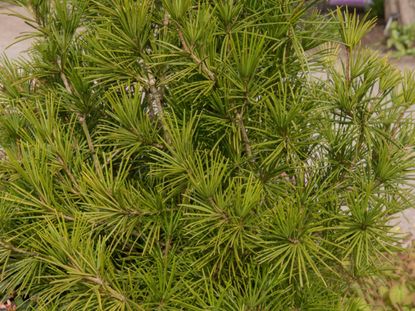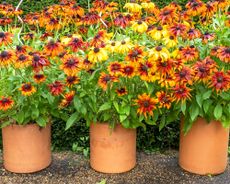Care Of Umbrella Pine Trees: Information About Japanese Umbrella Pine Planting


Japanese umbrella trees (Sciadopitys verticillata) are small, strikingly beautiful trees that never fail to draw attention. Called “koya-maki” in Japan, the tree is one of Japan’s five sacred trees. These richly textured conifers are rare and expensive in nurseries because they grow slowly and it takes a long time to grow a sapling large enough to sell. In the landscape, it can take 100 years for a sapling to reach mature size. Despite the extra expense and slow growth, these lovely trees are worth the effort. Let's find out more about Japanese umbrella pine trees.
Umbrella Pine Information
Growing Japanese umbrella pines is not for everyone. The tree is unusual, and people tend to either love or hate it. In Japan, the trees are associated with Buddhism in the Kyoto Prefecture. In fact, centuries ago Japanese umbrella pine trees were at the center of worship in Kyoto temples and became a part of Buddhist prayers. Legends associated with the trees in Japan include the belief that the women who stroke the whorls of the wood will conceive healthy children. In Mt. Kiso, Japan, residents set koyamaki branches on the graves of their loved ones in order to lead the spirits back to the land of the living. Umbrella pine trees aren't true pine trees. In fact, they are so unique that they are the only members of their family and genus. One of the first things you'll notice is the unusual texture. The shiny, dark green needles almost feel as though they are made of plastic. The needles are 2 to 5 inches (5 to 12.5 cm.) long and grow in whorls around the branches. Although they are generally spire-shaped, there are a few cultivars that take a more rounded form. The branches on young trees grow straight out, giving them a rigid appearance. As the tree ages, the branches become more pendulous and graceful. The ornamental reddish or orange bark sheds in long strips, adding to the exotic appeal. Once the tree matures, it sets cones that are 2 to 4 inches (5 to 10 cm.) long and 1 to 2 inches (2.5 to 5 cm.) wide. They start green and mature to brown. You can start trees from the seeds in fertilized cones if you don't mind the long wait. Rare because of the patience required to propagate them, you may have to ask your nurseryman to help you obtain an umbrella pine. Planting this unusual and lovely tree is something you'll never regret. The tree’s unique structure makes it a prized ornamental to those who find it beautiful.
Care of Umbrella Pine Trees
If you are thinking about growing Japanese umbrella pines, they thrive in U.S. Department of Agriculture plant hardiness zones 5 through 8a. It is exceptionally easy to grow and care for Japanese umbrella pines, but finding a good site is important. Even though the tree grows slowly, leave room for its mature size, which can get to 30 feet (9 m.) high and half that wide. Care of umbrella pine trees begins with careful site selection and preparation. The tree tolerates almost any exposure and can thrive in sun, partial sun, and partial shade. However, it does best with moderate or full sun. In warmer climates, you’ll want to care for Japanese umbrella pine by planting it where it will get morning sun and shade during the hottest part of the afternoon. Provide a sheltered site with protection from strong winds. Umbrella pines need organically rich soil that manages moisture well. For most locations, this means working a thick layer of compost or rotted manure into the soil before planting. It isn't enough to amend the soil in the planting hole because the roots need good soil as they spread into the surrounding area. Umbrella pines fail to thrive in heavy clay or alkaline soils. Keep the soil evenly moist throughout the tree's life. You'll probably have to water weekly during dry spells. Organic mulch will help the soil hold moisture and keep down weeds that compete for moisture and nutrients. They have few pests or diseases that cause problems and are resistant to Verticillium wilt.
Gardening tips, videos, info and more delivered right to your inbox!
Sign up for the Gardening Know How newsletter today and receive a free download of our most popular eBook "How to Grow Delicious Tomatoes."

Jackie Carroll has written over 500 articles for Gardening Know How on a wide range of topics.
-
 8 Flowering Perennials For Pots – To Bring Joy Every Year
8 Flowering Perennials For Pots – To Bring Joy Every YearThese beautiful perennials are long-term investments for your container garden, as they will return year after year with a profusion of blooms.
By Amy Grant
-
 Can You Kill Grass With Cardboard?
Can You Kill Grass With Cardboard?Try killing grass with cardboard, or sheet mulching. Killing grass with cardboard is an easy way to ditch the lawn.
By Susan Albert